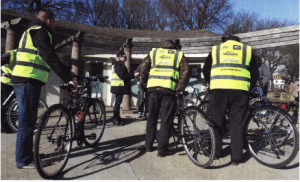It may not seem a likely sight – a group of seasoned truckers taking to the road on bikes with an instructor – but it’s a growing phenomenon. In 2003, the EU passed the DCPC (Driver Certificate of Professional Competence) Directive. This requires all professional urban LGV and PCV drivers to complete training designed to promote the safe sharing of roads with vulnerable road users, particularly cyclists. Mel Holley from routeOne magazine attended one such course and he sent this report.
While the lycra-clad, law-breaking power cyclist is one particular stereotype – especially in London – in reality, a variety of people cycle, and relatively few have the devil-may-care aggressive attitude that the image suggests. Indeed, fear of accidents is a key worry for many cyclists, especially the less confident.
In the same way as only by sitting in the cab of a coach or bus can a cyclist fully appreciate the driver’s vision and why we position our vehicles where we do such as when turning left, changing places with cyclists is an equal eye-opener for PCV drivers, even those who are lapsed in the saddle.
Meanwhile, for those who complain about the cost of the Driver CPC (DCPC) renewal, there is good news in that most councils have secured government funding to run these so that all you pay is the £8.75 upload fee.
Run by Cycle Confident, using their local trainer Alec Horner of Minimise Your Risk, the Safer Urban Driving course aims to highlight ways you can improve your driving and understand the behaviour of cyclists.
With a mix of PCV and LGV drivers, the morning started with outlines of the issues that drivers and cyclists face, supported by recent videos covering high-profile situations in the capital. Unsurprisingly, this provoked some lively discussion and was anything but dull.
Then, with assistance from cycle training professionals, we moved on to the practical session – optional for those who felt unable to take part. Snazzy new cycles were provided and coaching took place in an off-road cycle lane, including checking that participants could do basic tasks such as indicate, look over their shoulder and perform an emergency stop.
Key points include understanding how modern cycle training has changed. For example, cyclists are now trained to ride in a more assertive position on the road – to be seen more easily (particularly at junctions).
Then we set off in a hi-viz crocodile onto Brighton’s busy roads, with three short demonstration rides, exposing us to various situations.
We quickly learnt a number of important lessons (aside from the impatience of some motorists) including that cycle lanes are not always in helpful places.
In one case, a narrow lane put riders directly in danger of having a car door opened on them, which would knock them off (into the traffic lane), or force them to swerve, again into the traffic lane.
This didn’t happen, but the danger was clear and it became easier to understand why cyclists don’t always use cycle lanes, or position themselves where we would expect. The benefit of advanced stop lines at a complex junction were also demonstrated.
Experiencing first-hand what it’s like to be a modern-day cyclist, especially for those who had not been in the saddle for a while, was incredibly powerful. Understanding what a cyclist might do next, and why, proved a useful education.
For information on Driver CPC courses run by Cycle Confident, click here.

Leave a Reply